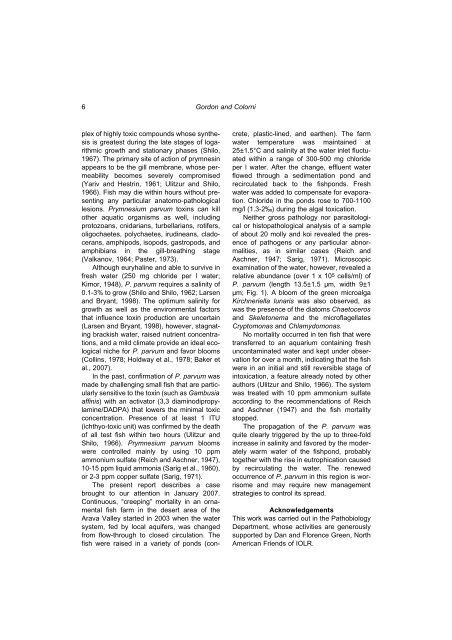Short Communication Prymnesium parvum, an Ichthyotoxic Alga in ...
Short Communication Prymnesium parvum, an Ichthyotoxic Alga in ...
Short Communication Prymnesium parvum, an Ichthyotoxic Alga in ...
Create successful ePaper yourself
Turn your PDF publications into a flip-book with our unique Google optimized e-Paper software.
6<br />
Gordon <strong>an</strong>d Colorni<br />
plex of highly toxic compounds whose synthesis<br />
is greatest dur<strong>in</strong>g the late stages of logarithmic<br />
growth <strong>an</strong>d stationary phases (Shilo,<br />
1967). The primary site of action of prymnes<strong>in</strong><br />
appears to be the gill membr<strong>an</strong>e, whose permeability<br />
becomes severely compromised<br />
(Yariv <strong>an</strong>d Hestr<strong>in</strong>, 1961; Ulitzur <strong>an</strong>d Shilo,<br />
1966). Fish may die with<strong>in</strong> hours without present<strong>in</strong>g<br />
<strong>an</strong>y particular <strong>an</strong>atomo-pathological<br />
lesions. <strong>Prymnesium</strong> <strong>parvum</strong> tox<strong>in</strong>s c<strong>an</strong> kill<br />
other aquatic org<strong>an</strong>isms as well, <strong>in</strong>clud<strong>in</strong>g<br />
protozo<strong>an</strong>s, cnidari<strong>an</strong>s, turbellari<strong>an</strong>s, rotifers,<br />
oligochaetes, polychaetes, irud<strong>in</strong>e<strong>an</strong>s, cladocer<strong>an</strong>s,<br />
amphipods, isopods, gastropods, <strong>an</strong>d<br />
amphibi<strong>an</strong>s <strong>in</strong> the gill-breath<strong>in</strong>g stage<br />
(Valk<strong>an</strong>ov, 1964; Paster, 1973).<br />
Although euryhal<strong>in</strong>e <strong>an</strong>d able to survive <strong>in</strong><br />
fresh water (250 mg chloride per l water;<br />
Kimor, 1948), P. <strong>parvum</strong> requires a sal<strong>in</strong>ity of<br />
0.1-3% to grow (Shilo <strong>an</strong>d Shilo, 1962; Larsen<br />
<strong>an</strong>d Bry<strong>an</strong>t, 1998). The optimum sal<strong>in</strong>ity for<br />
growth as well as the environmental factors<br />
that <strong>in</strong>fluence tox<strong>in</strong> production are uncerta<strong>in</strong><br />
(Larsen <strong>an</strong>d Bry<strong>an</strong>t, 1998), however, stagnat<strong>in</strong>g<br />
brackish water, raised nutrient concentrations,<br />
<strong>an</strong>d a mild climate provide <strong>an</strong> ideal ecological<br />
niche for P. <strong>parvum</strong> <strong>an</strong>d favor blooms<br />
(Coll<strong>in</strong>s, 1978; Holdway et al., 1978; Baker et<br />
al., 2007).<br />
In the past, confirmation of P. <strong>parvum</strong> was<br />
made by challeng<strong>in</strong>g small fish that are particularly<br />
sensitive to the tox<strong>in</strong> (such as Gambusia<br />
aff<strong>in</strong>is) with <strong>an</strong> activator (3,3 diam<strong>in</strong>odipropylam<strong>in</strong>e/DADPA)<br />
that lowers the m<strong>in</strong>imal toxic<br />
concentration. Presence of at least 1 ITU<br />
(ichthyo-toxic unit) was confirmed by the death<br />
of all test fish with<strong>in</strong> two hours (Ulitzur <strong>an</strong>d<br />
Shilo, 1966). <strong>Prymnesium</strong> <strong>parvum</strong> blooms<br />
were controlled ma<strong>in</strong>ly by us<strong>in</strong>g 10 ppm<br />
ammonium sulfate (Reich <strong>an</strong>d Aschner, 1947),<br />
10-15 ppm liquid ammonia (Sarig et al., 1960),<br />
or 2-3 ppm copper sulfate (Sarig, 1971).<br />
The present report describes a case<br />
brought to our attention <strong>in</strong> J<strong>an</strong>uary 2007.<br />
Cont<strong>in</strong>uous, “creep<strong>in</strong>g” mortality <strong>in</strong> <strong>an</strong> ornamental<br />
fish farm <strong>in</strong> the desert area of the<br />
Arava Valley started <strong>in</strong> 2003 when the water<br />
system, fed by local aquifers, was ch<strong>an</strong>ged<br />
from flow-through to closed circulation. The<br />
fish were raised <strong>in</strong> a variety of ponds (concrete,<br />
plastic-l<strong>in</strong>ed, <strong>an</strong>d earthen). The farm<br />
water temperature was ma<strong>in</strong>ta<strong>in</strong>ed at<br />
25±1.5°C <strong>an</strong>d sal<strong>in</strong>ity at the water <strong>in</strong>let fluctuated<br />
with<strong>in</strong> a r<strong>an</strong>ge of 300-500 mg chloride<br />
per l water. After the ch<strong>an</strong>ge, effluent water<br />
flowed through a sedimentation pond <strong>an</strong>d<br />
recirculated back to the fishponds. Fresh<br />
water was added to compensate for evaporation.<br />
Chloride <strong>in</strong> the ponds rose to 700-1100<br />
mg/l (1.3-2‰) dur<strong>in</strong>g the algal toxication.<br />
Neither gross pathology nor parasitological<br />
or histopathological <strong>an</strong>alysis of a sample<br />
of about 20 molly <strong>an</strong>d koi revealed the presence<br />
of pathogens or <strong>an</strong>y particular abnormalities,<br />
as <strong>in</strong> similar cases (Reich <strong>an</strong>d<br />
Aschner, 1947; Sarig, 1971). Microscopic<br />
exam<strong>in</strong>ation of the water, however, revealed a<br />
relative abund<strong>an</strong>ce (over 1 x 105 cells/ml) of<br />
P. <strong>parvum</strong> (length 13.5±1.5 µm, width 9±1<br />
µm; Fig. 1). A bloom of the green microalga<br />
Kirchneriella lunaris was also observed, as<br />
was the presence of the diatoms Chaetoceros<br />
<strong>an</strong>d Skeletonema <strong>an</strong>d the microflagellates<br />
Cryptomonas <strong>an</strong>d Chlamydomonas.<br />
No mortality occurred <strong>in</strong> ten fish that were<br />
tr<strong>an</strong>sferred to <strong>an</strong> aquarium conta<strong>in</strong><strong>in</strong>g fresh<br />
uncontam<strong>in</strong>ated water <strong>an</strong>d kept under observation<br />
for over a month, <strong>in</strong>dicat<strong>in</strong>g that the fish<br />
were <strong>in</strong> <strong>an</strong> <strong>in</strong>itial <strong>an</strong>d still reversible stage of<br />
<strong>in</strong>toxication, a feature already noted by other<br />
authors (Ulitzur <strong>an</strong>d Shilo, 1966). The system<br />
was treated with 10 ppm ammonium sulfate<br />
accord<strong>in</strong>g to the recommendations of Reich<br />
<strong>an</strong>d Aschner (1947) <strong>an</strong>d the fish mortality<br />
stopped.<br />
The propagation of the P. <strong>parvum</strong> was<br />
quite clearly triggered by the up to three-fold<br />
<strong>in</strong>crease <strong>in</strong> sal<strong>in</strong>ity <strong>an</strong>d favored by the moderately<br />
warm water of the fishpond, probably<br />
together with the rise <strong>in</strong> eutrophication caused<br />
by recirculat<strong>in</strong>g the water. The renewed<br />
occurrence of P. <strong>parvum</strong> <strong>in</strong> this region is worrisome<br />
<strong>an</strong>d may require new m<strong>an</strong>agement<br />
strategies to control its spread.<br />
Acknowledgements<br />
This work was carried out <strong>in</strong> the Pathobiology<br />
Department, whose activities are generously<br />
supported by D<strong>an</strong> <strong>an</strong>d Florence Green, North<br />
Americ<strong>an</strong> Friends of IOLR.


